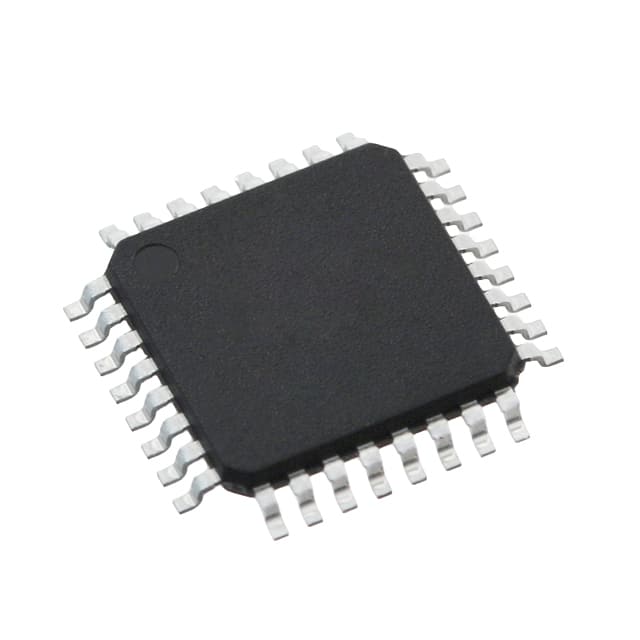ATMEGA64M1-15AZ
Product Overview
Category
ATMEGA64M1-15AZ belongs to the category of microcontrollers.
Use
This product is commonly used in various electronic devices and systems that require embedded control.
Characteristics
- Microcontroller with advanced features
- High-performance and low-power consumption
- Suitable for applications requiring real-time control
- Offers a wide range of peripherals and interfaces
Package
ATMEGA64M1-15AZ is available in a compact and durable package, ensuring easy integration into electronic circuits.
Essence
The essence of ATMEGA64M1-15AZ lies in its ability to provide efficient and reliable control for a wide range of applications.
Packaging/Quantity
ATMEGA64M1-15AZ is typically packaged in reels or trays, with varying quantities depending on the manufacturer's specifications.
Specifications
- Microcontroller Architecture: AVR
- Flash Memory: 64KB
- RAM: 4KB
- Operating Voltage: 2.7V - 5.5V
- Maximum Clock Frequency: 16MHz
- Number of I/O Pins: 53
- Communication Interfaces: UART, SPI, I2C
- Analog-to-Digital Converter (ADC): 10-bit, 8 channels
- Timers/Counters: 6
- PWM Channels: 6
- Operating Temperature Range: -40°C to +85°C
Detailed Pin Configuration
The pin configuration of ATMEGA64M1-15AZ is as follows:

Functional Features
- Advanced control capabilities
- Real-time performance
- Multiple communication interfaces for data exchange
- Flexible and configurable I/O pins
- Analog-to-Digital Converter for precise measurements
- Timers and counters for accurate timing operations
- PWM channels for controlling analog devices
Advantages and Disadvantages
Advantages
- High-performance microcontroller
- Low-power consumption
- Wide operating voltage range
- Extensive peripheral options
- Suitable for real-time control applications
Disadvantages
- Limited flash memory compared to some other microcontrollers in the same category
- Relatively higher cost compared to entry-level microcontrollers
Working Principles
ATMEGA64M1-15AZ operates based on the AVR architecture, which utilizes a modified Harvard architecture. It executes instructions stored in its flash memory, interacts with peripherals and interfaces, and performs various control tasks according to the program loaded onto it.
Detailed Application Field Plans
ATMEGA64M1-15AZ finds applications in various fields, including but not limited to: - Industrial automation - Consumer electronics - Automotive systems - Medical devices - Internet of Things (IoT) devices - Robotics
Detailed and Complete Alternative Models
Some alternative models that offer similar functionality to ATMEGA64M1-15AZ are: - ATMEGA128M1-15AZ - ATMEGA32M1-15AZ - ATMEGA256M1-15AZ - ATMEGA16M1-15AZ
These models provide different memory capacities and pin configurations, allowing users to choose the most suitable option for their specific requirements.
In conclusion, ATMEGA64M1-15AZ is a high-performance microcontroller with advanced features, suitable for a wide range of applications. Its efficient control capabilities, flexible I/O pins, and extensive peripheral options make it a popular choice among developers in various industries. While it may have some limitations in terms of memory capacity and cost, alternative models are available to cater to different needs.
Lista 10 Vanliga frågor och svar relaterade till tillämpningen av ATMEGA64M1-15AZ i tekniska lösningar
Sure! Here are 10 common questions and answers related to the application of ATMEGA64M1-15AZ in technical solutions:
Q1: What is the ATMEGA64M1-15AZ? A1: The ATMEGA64M1-15AZ is a microcontroller from the AVR family, manufactured by Microchip. It features 64KB of flash memory, 4KB of SRAM, and various peripherals.
Q2: What are the main features of the ATMEGA64M1-15AZ? A2: The main features include a 16MHz clock speed, 64KB of flash memory for program storage, multiple communication interfaces (UART, SPI, I2C), analog-to-digital converters, timers, and GPIO pins.
Q3: What applications can the ATMEGA64M1-15AZ be used for? A3: The ATMEGA64M1-15AZ can be used in a wide range of applications such as industrial automation, consumer electronics, home automation, robotics, and automotive systems.
Q4: How do I program the ATMEGA64M1-15AZ? A4: The ATMEGA64M1-15AZ can be programmed using various development tools like Atmel Studio, MPLAB X IDE, or Arduino IDE. You can use a programmer/debugger like Atmel-ICE or PICkit to connect to the microcontroller.
Q5: Can I use the ATMEGA64M1-15AZ with Arduino? A5: Yes, you can use the ATMEGA64M1-15AZ with Arduino. However, since it is not a standard Arduino board, you will need to set up the necessary hardware connections and configure the Arduino IDE accordingly.
Q6: What voltage does the ATMEGA64M1-15AZ operate at? A6: The ATMEGA64M1-15AZ operates at a voltage range of 1.8V to 5.5V.
Q7: Does the ATMEGA64M1-15AZ have built-in analog-to-digital converters (ADC)? A7: Yes, the ATMEGA64M1-15AZ has a 10-bit ADC with multiple channels, allowing you to convert analog signals into digital values.
Q8: Can I use the ATMEGA64M1-15AZ for wireless communication? A8: Yes, you can use the ATMEGA64M1-15AZ for wireless communication by connecting external modules like Wi-Fi or Bluetooth transceivers to its UART or SPI interfaces.
Q9: How many GPIO pins does the ATMEGA64M1-15AZ have? A9: The ATMEGA64M1-15AZ has a total of 54 GPIO pins, which can be used for various purposes such as digital input/output, PWM output, or interrupt handling.
Q10: Is the ATMEGA64M1-15AZ suitable for low-power applications? A10: Yes, the ATMEGA64M1-15AZ is suitable for low-power applications. It offers various power-saving modes and features like sleep mode, idle mode, and power reduction registers to minimize power consumption.
Please note that these answers are general and may vary depending on specific requirements and configurations in your technical solution.


